I knew one thing about Ely because it pops up in crosswords – an English Cathedral City / 3 letters (can’t be too many of those!) What I didn’t know was its location – until last year. En route by train to Cambridge from Stansted Airport, there was Ely – popping up again – the next stop, some 20 minutes further on. That’s doable, she thinks, reckoning that should we ever repeat the journey, Ely would be worth a visit. Well – we did repeat the journey……
And that’s how we ended up in Ely last week.
I know a bit more about the place now……
For starters, we had the pronunciation wrong! Hopefully, we didn’t say Eel – eye too many times before picking up on Eel – ee! (Don’t you just hate it when everyone knows you’re a tourist!!😅 😂 🤣)
Ely’s name comes from…… EELS which inhabited the local marshes (I was rather disappointed with that!)
It’s the second smallest city in England.
The Cathedral is the fourth longest in the UK.
It’s Lady’s Chapel is the largest in the UK.
It’s charming, to say the least, and well worth a visit!
Thanks to an 8.00am Dublin-Stansted flight, the 50 minute train journey got us into Ely by 11.30am. We’d booked The Lamb Hotel for one night and the London train for the following afternoon so had some 28 hours at our disposal.
The 15 minute stroll from the station to The Lamb suggests a pleasant, well-kept rural market town – certainly not a city! The centre and High Street are compact and offer pubs, coffee shops and a smattering of restaurants. You can’t get lost – not just because it’s tiny, but because there are signposts everywhere – the local tourist board has done a lot of work in promoting the town’s attractions.



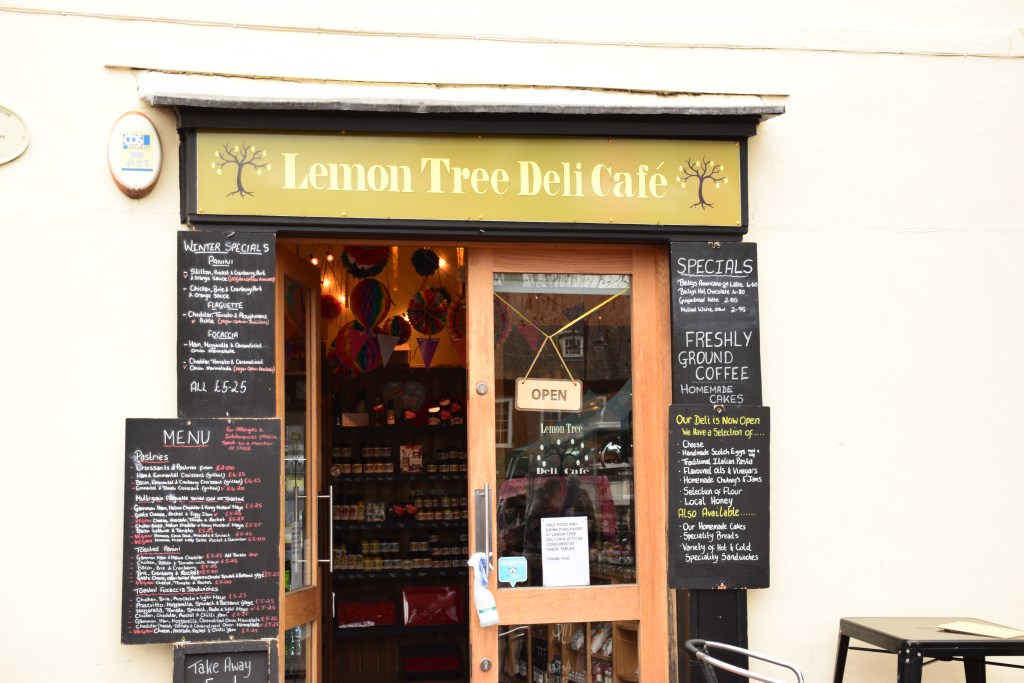

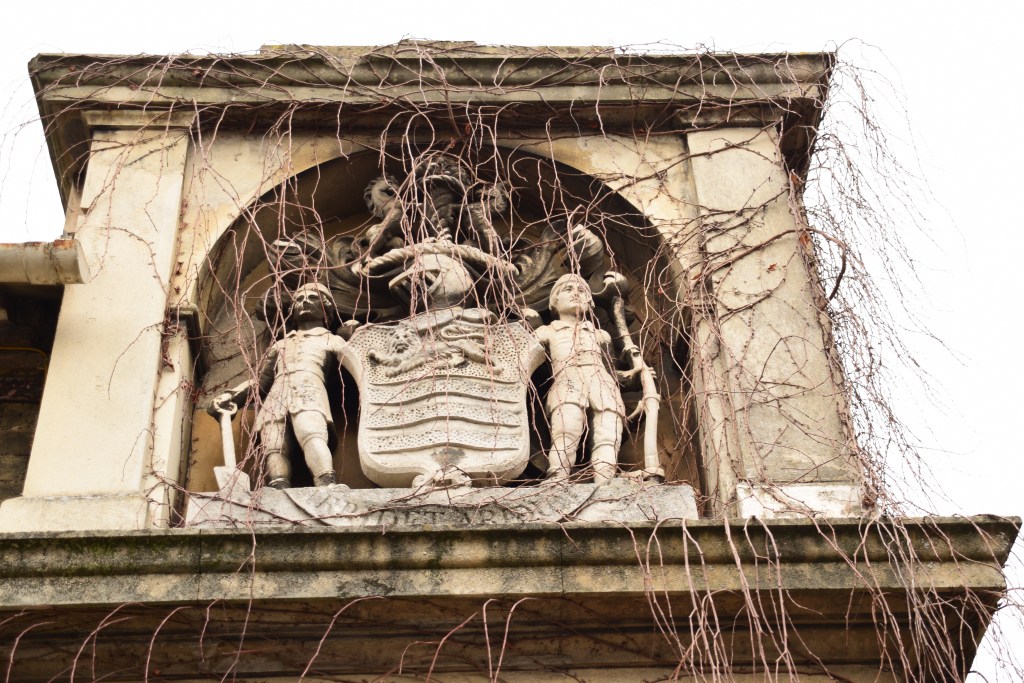



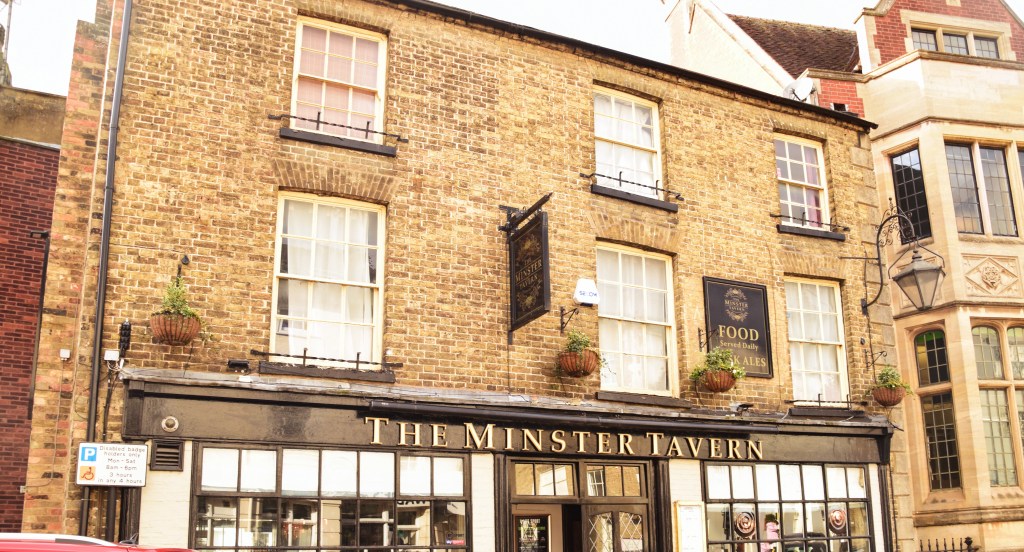
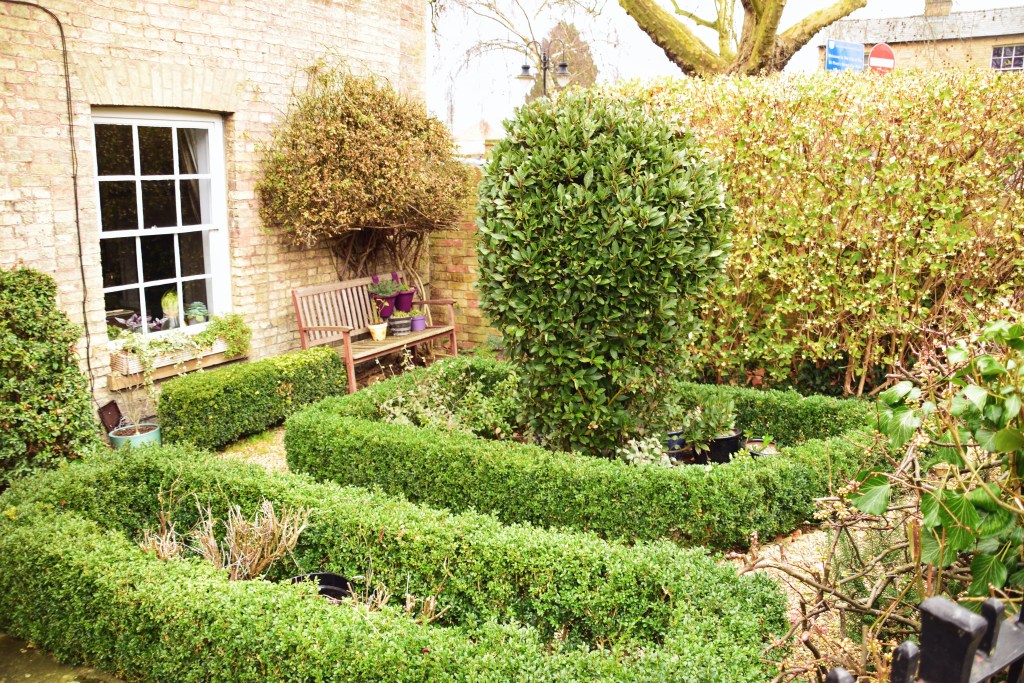
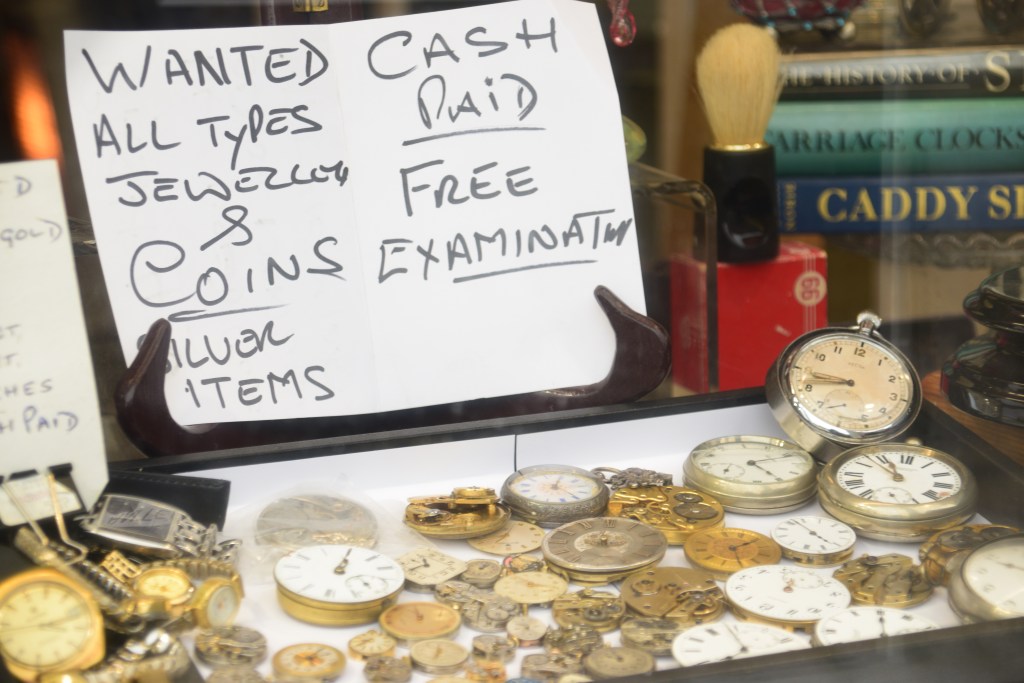
Thursday is Market Day which is a nice bonus if your visit coincides …..




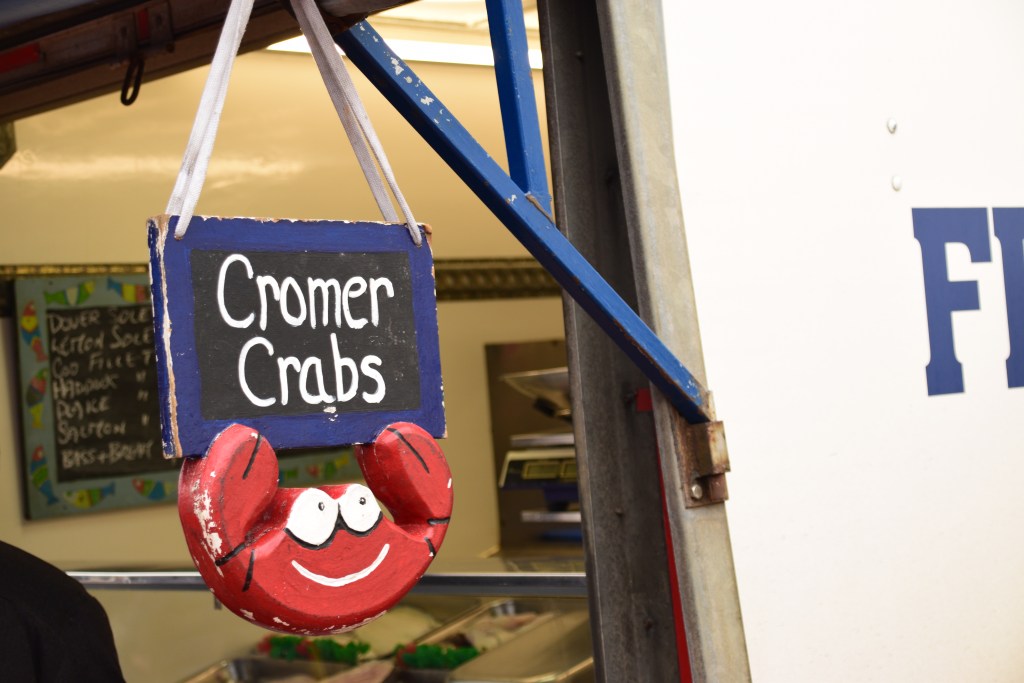

The Cathedral IS impressive!
Its history stretches back to 673 when a Saxon Queen, Etheldreda, founded a monastery on the site. The building of today’s Cathedral began in the 11th century and it was to become a prominent Benedictine monastery – the second wealthiest in the country (rivalled only by Glastonbury) It was closed by Henry VIII in 1539.
Henry and his advisors pondered over the role – if any – that cathedrals might play in the emerging Protestant Church. In the end, they were spared to serve three useful functions – propagation of true worship of God, care for the poor and education. In 1541, Ely was granted a new charter and the cathedral was re-founded.
Many members of the previous monastic community were reappointed to assist with worship. A grammar school was established and silver and vestments were sold to fund books and a library. An almshouse with six beds was set up in a passageway. While there was damage to statues and stained glass during the period of Protestant religious reform, the main structure remained intact although much of it serving very little purpose.

Major building projects of the era tended to be both expensive and time-consuming so construction and renovation tended to be piecemeal and a drawn-out affair. Here at Ely, Romanesque and Norman architecture styles share space with Early English, Decorated and Perpendicular among others.

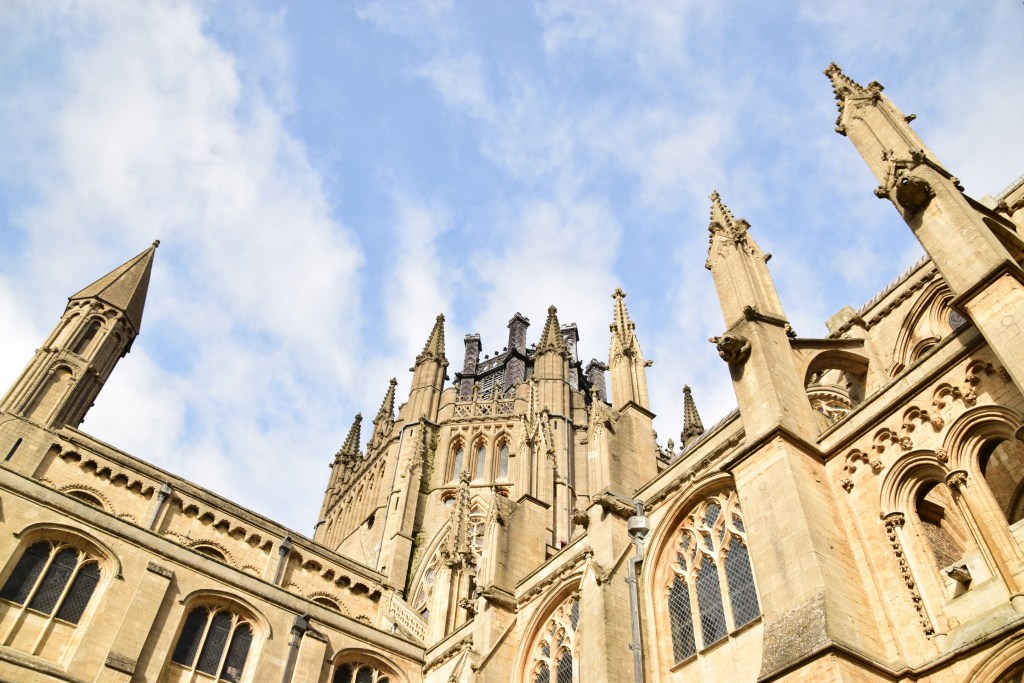


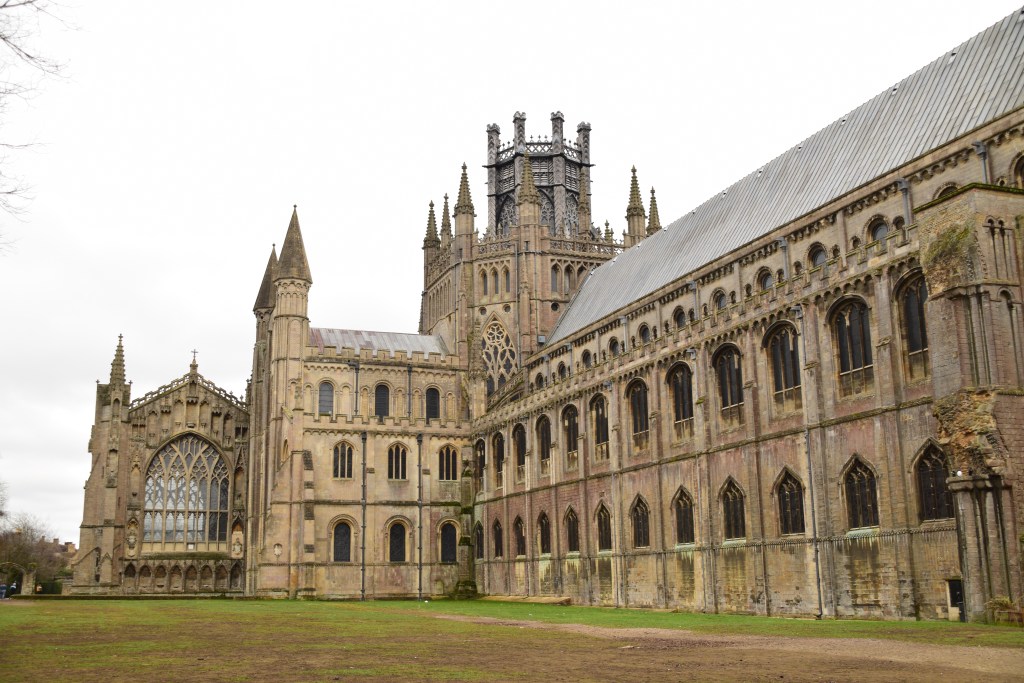
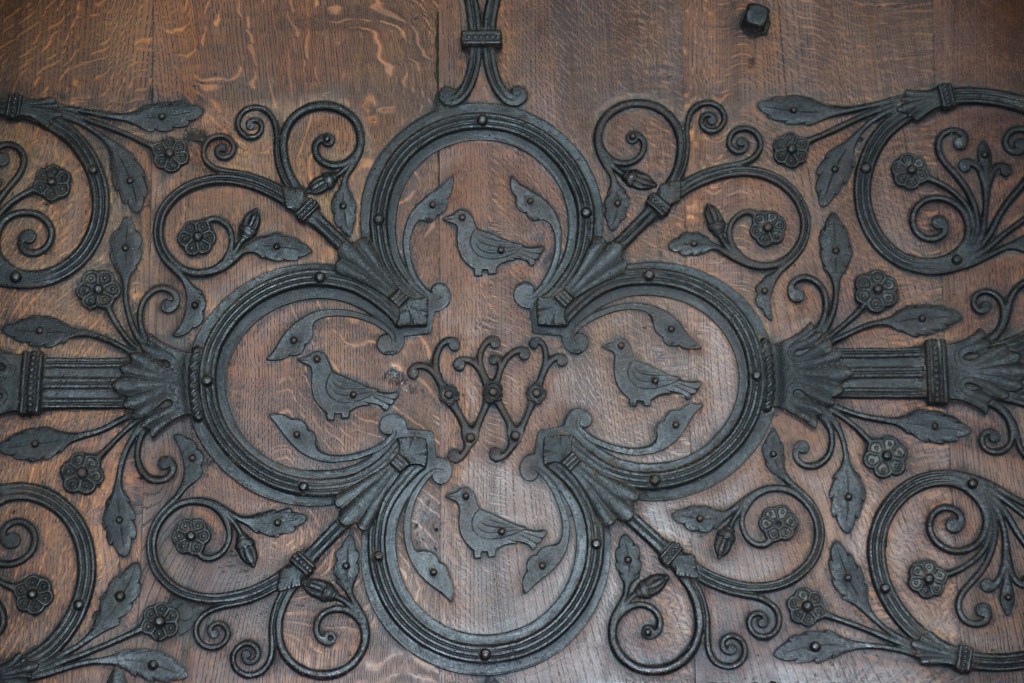

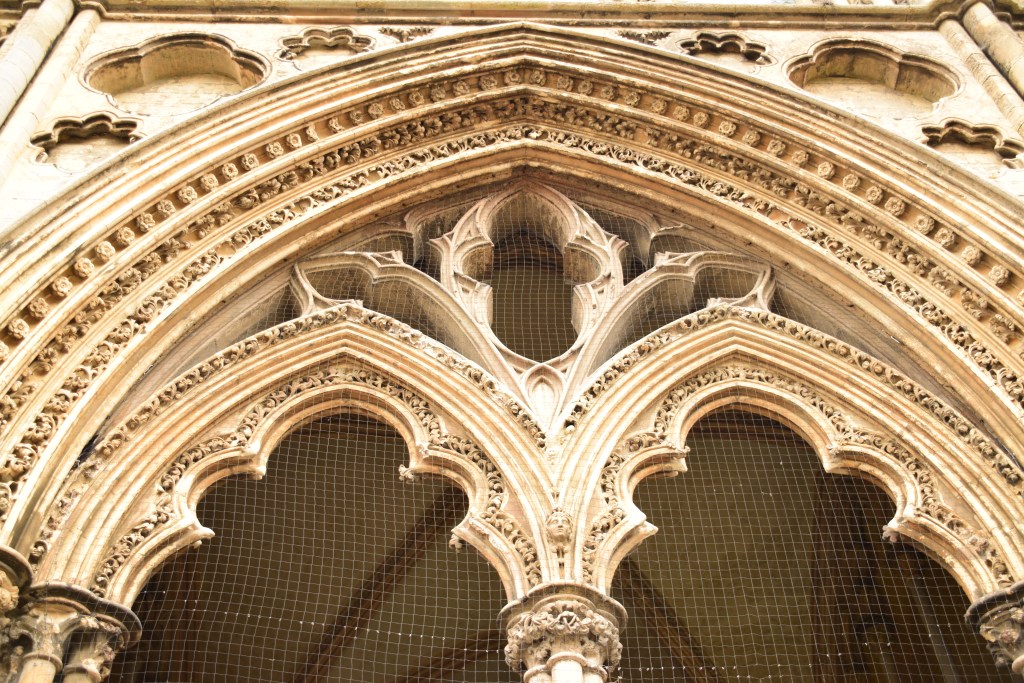

The nave is the third longest in the UK (and the same length as Ely High Street!!) and is roofed with spectacular painted panels.

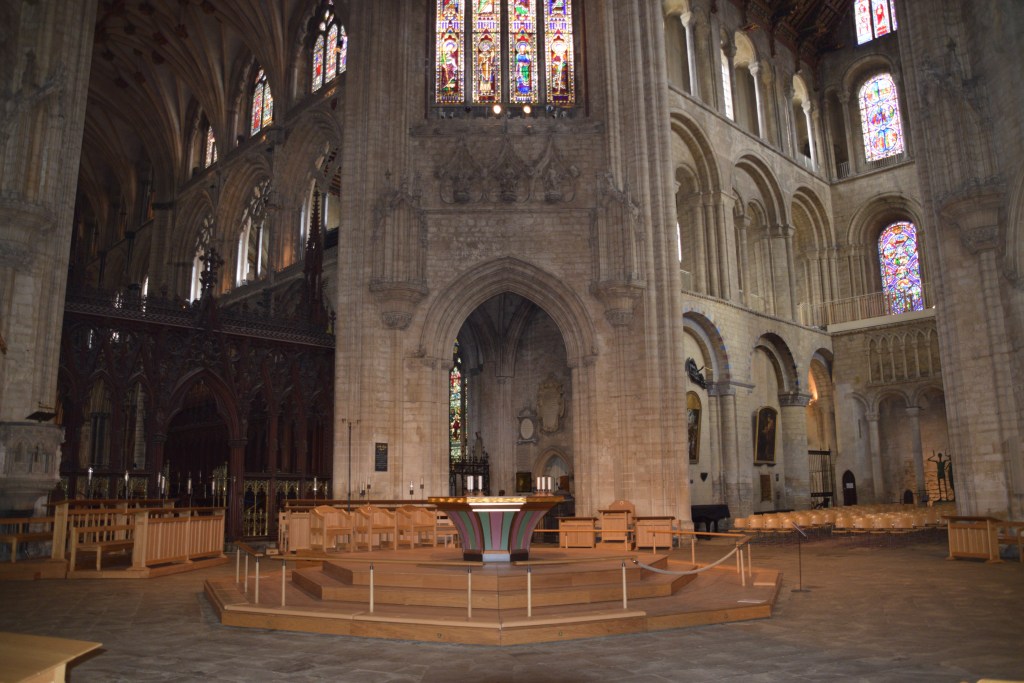
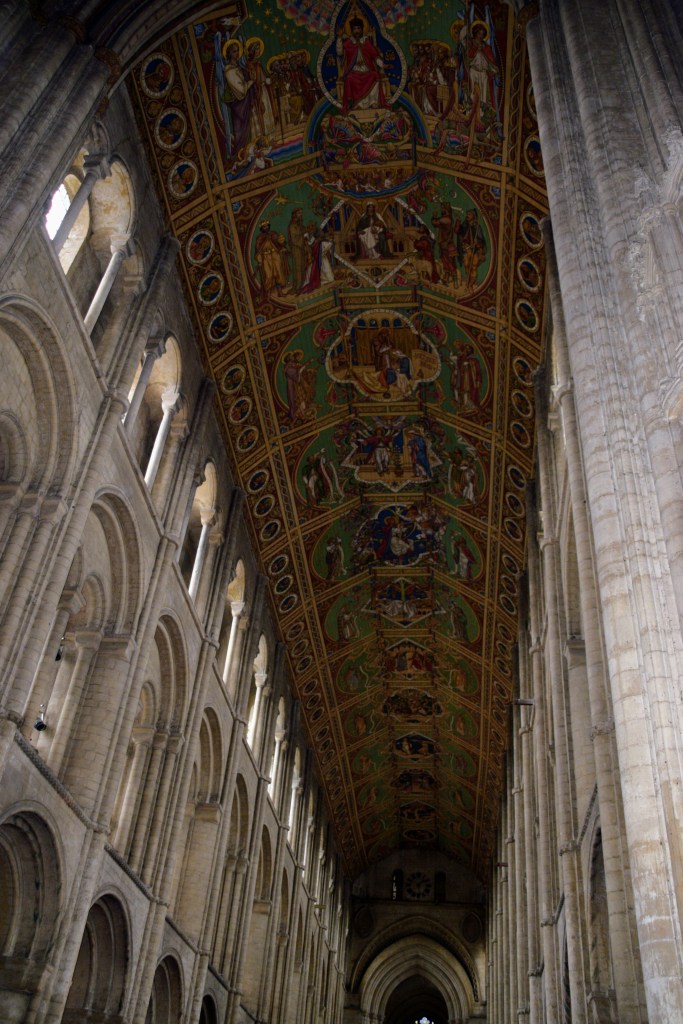

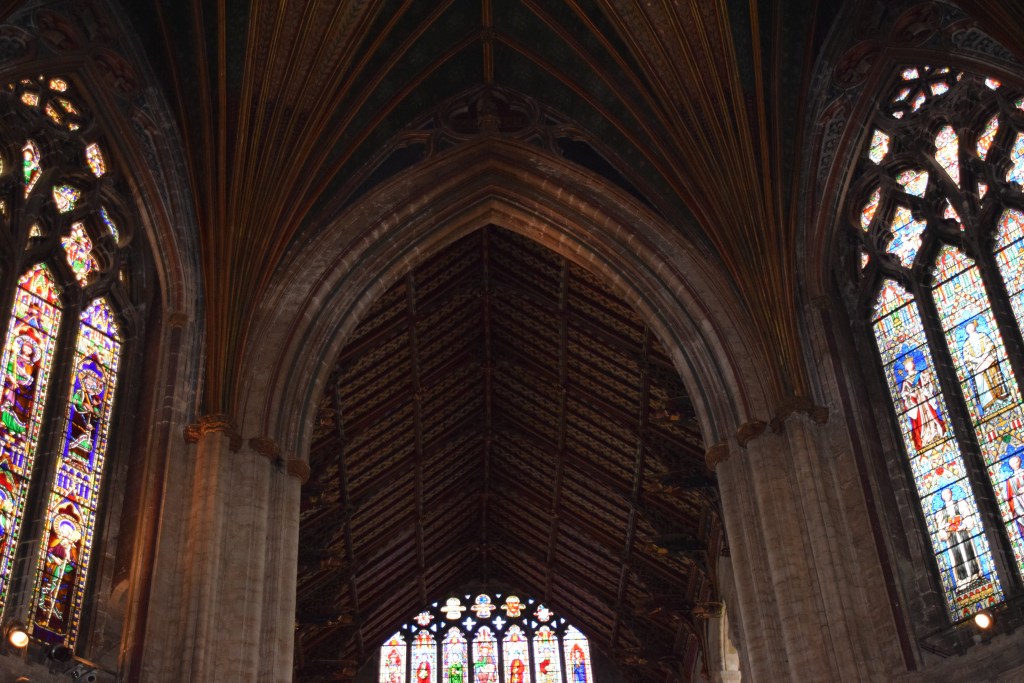
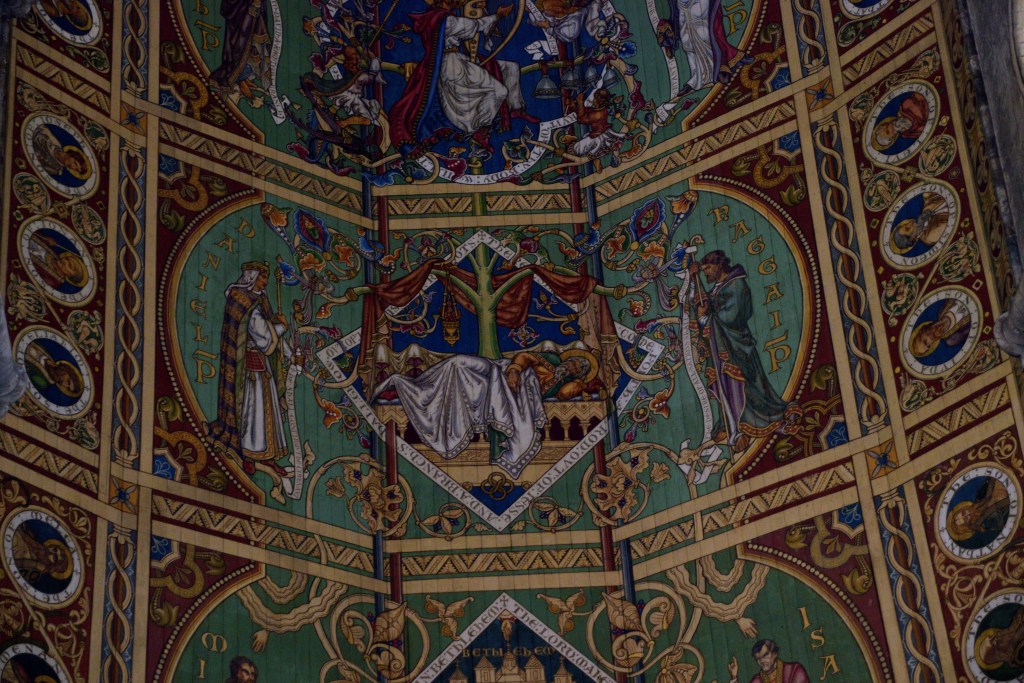
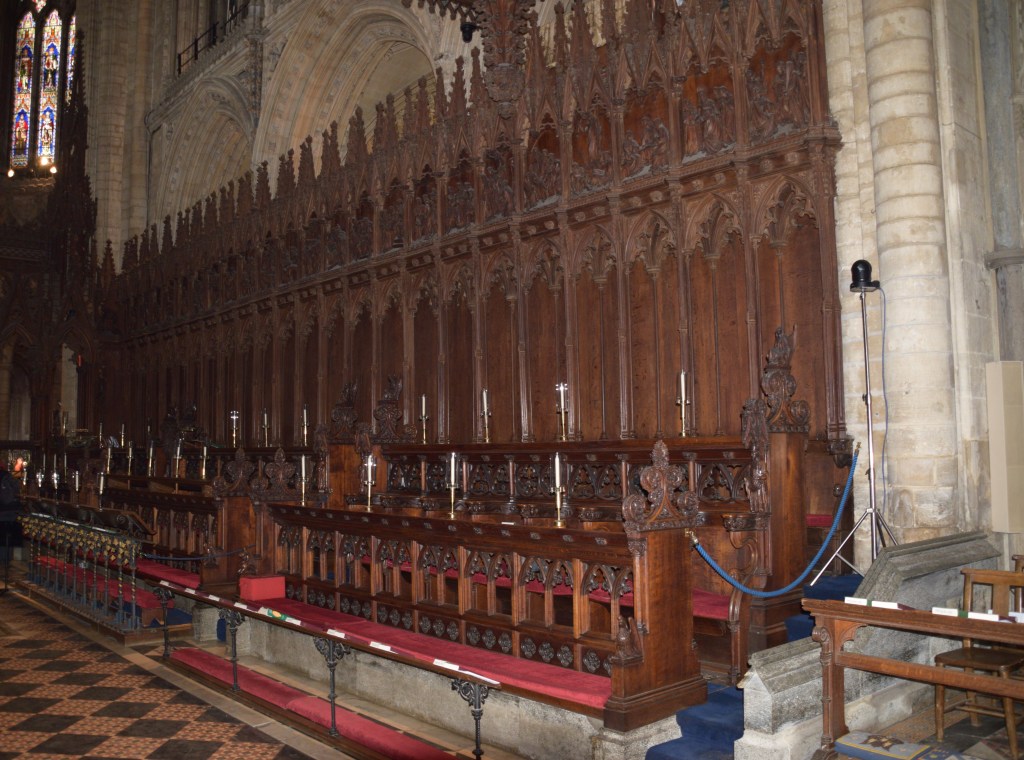
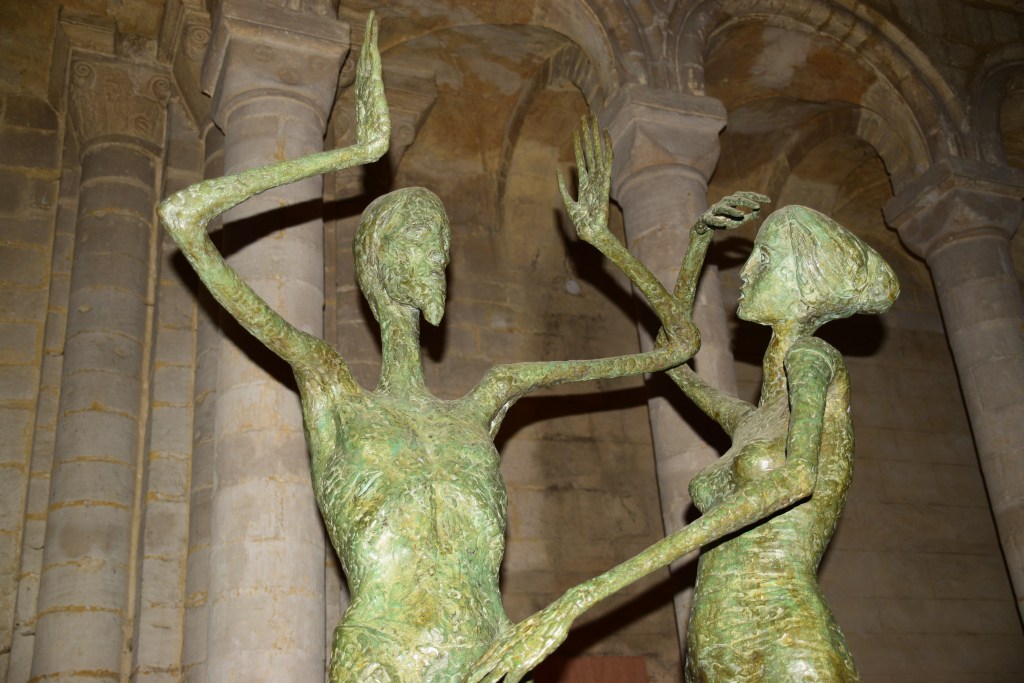

Disaster struck the cathedral in 1322 when, on the night of February 13th, the Norman central tower collapsed. Such was the noise that the monks thought it was an earthquake but the collapse was more likely caused by the digging of foundations for the nearby Lady Chapel. Devastating as this was for the community, it made way for the creation of one of the most remarkable structures of the English Middle Ages – indeed, one of the Wonders of the Medieval World.
Alan of Walsingham, sub-prior of the cathedral and an architect by trade, set about rebuilding the tower. With firmer foundations in place over a much enlarged base, the idea evolved of a tall octagonal structure surmounted by a lantern to allow in light. The tower wouldn’t support a stone vaulted roof so huge oak beams were used which were covered in lead. By 1340, the work was done and the ceiling was carved and painted.


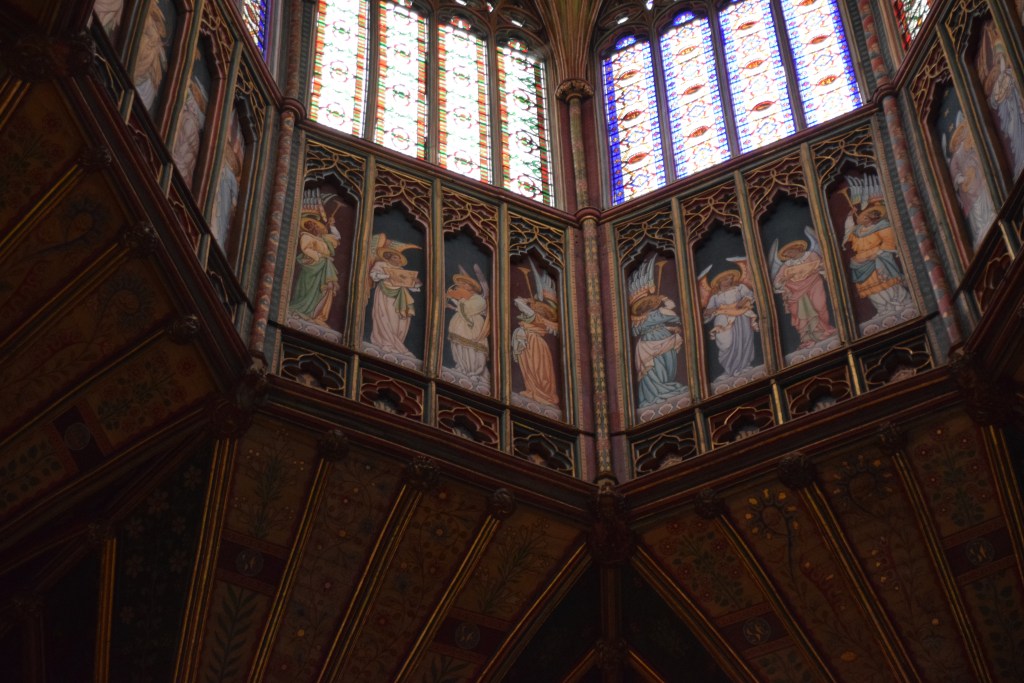
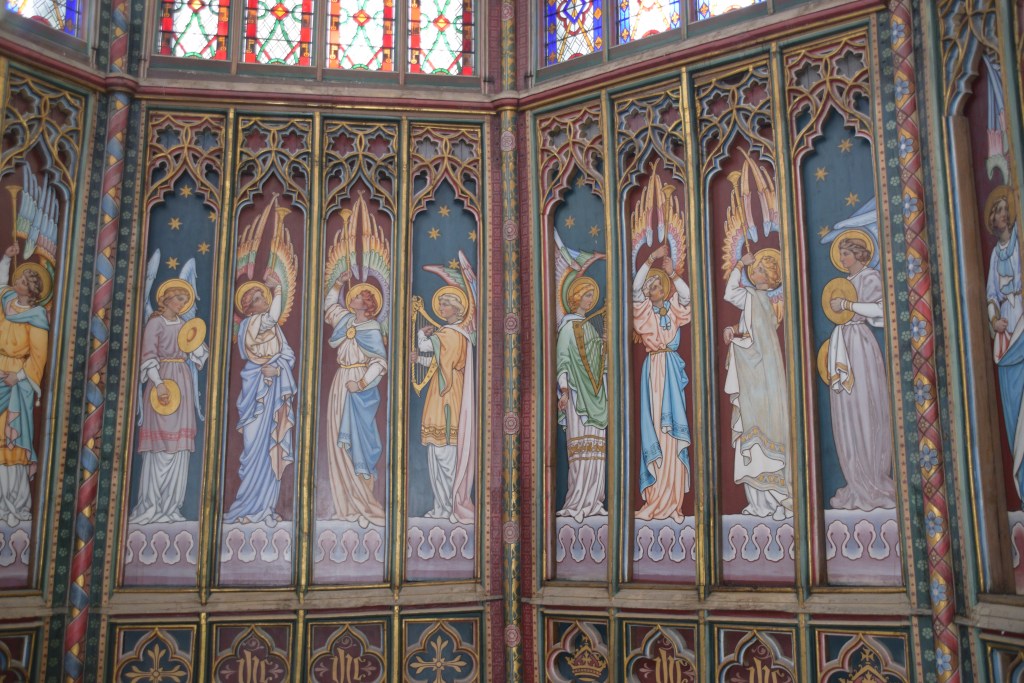
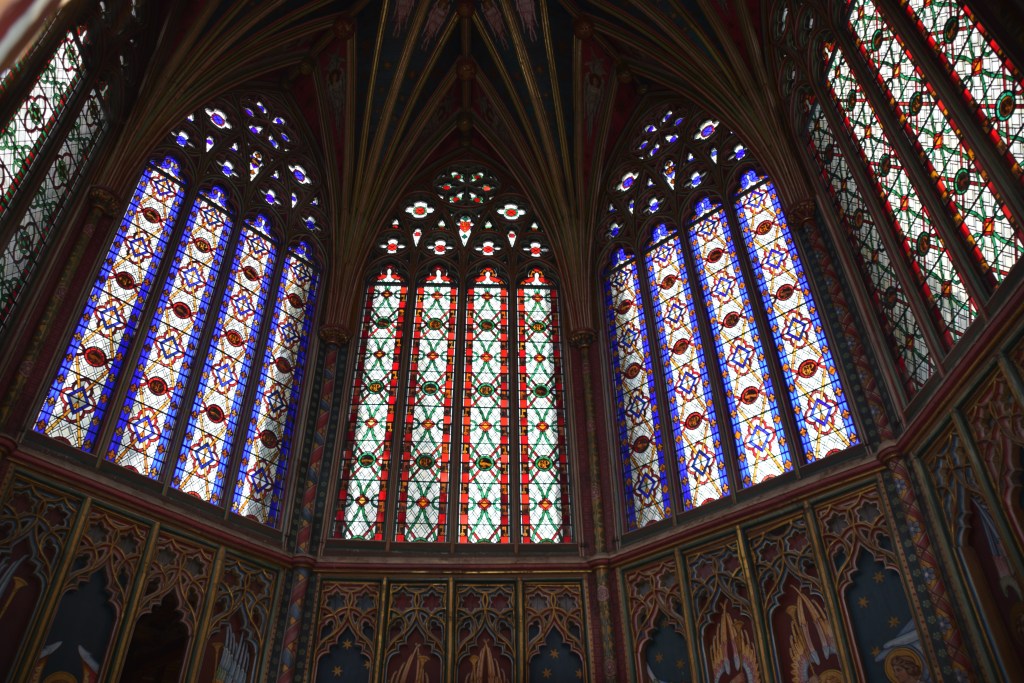
The coloured panels open to allow a view down into the Nave far below..



Once the Octagon was completed, attention was turned back to the Lady Chapel which had been put on hold (a Lady Chapel is dedicated to the Virgin Mary). Completed in 1349, the rectangular structure is the largest of its kind in the UK. The destruction of the Reformation is visible here, in the beheaded and defaced carvings.

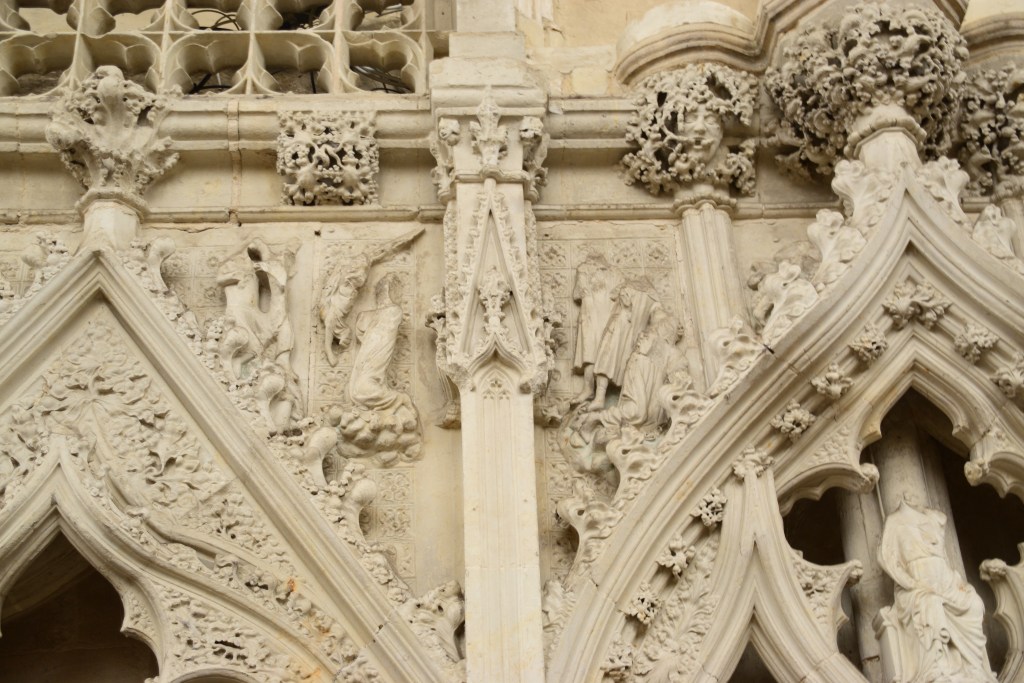
It’s worth taking the Octagon Tower Tour, Not alone to get up close to the Lantern, but for access to the roof of the cathedral..

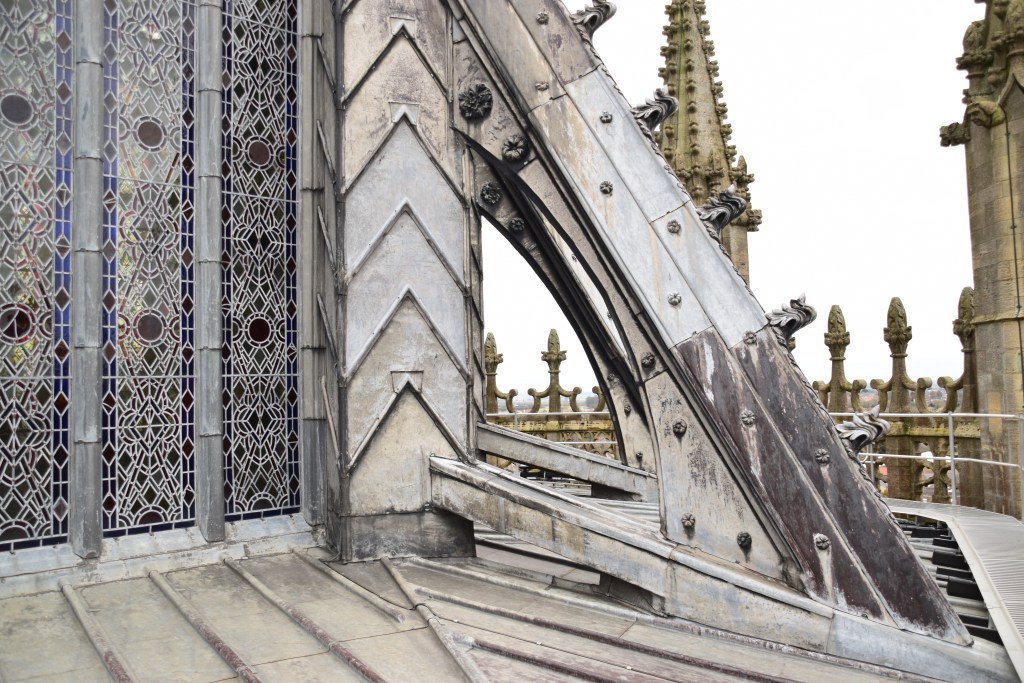

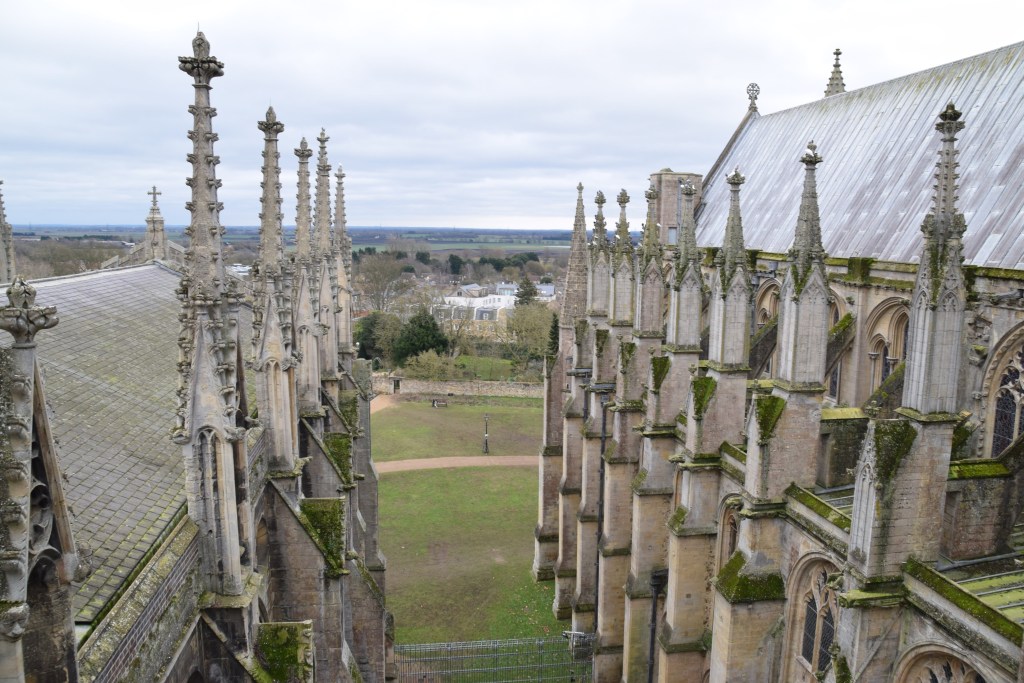
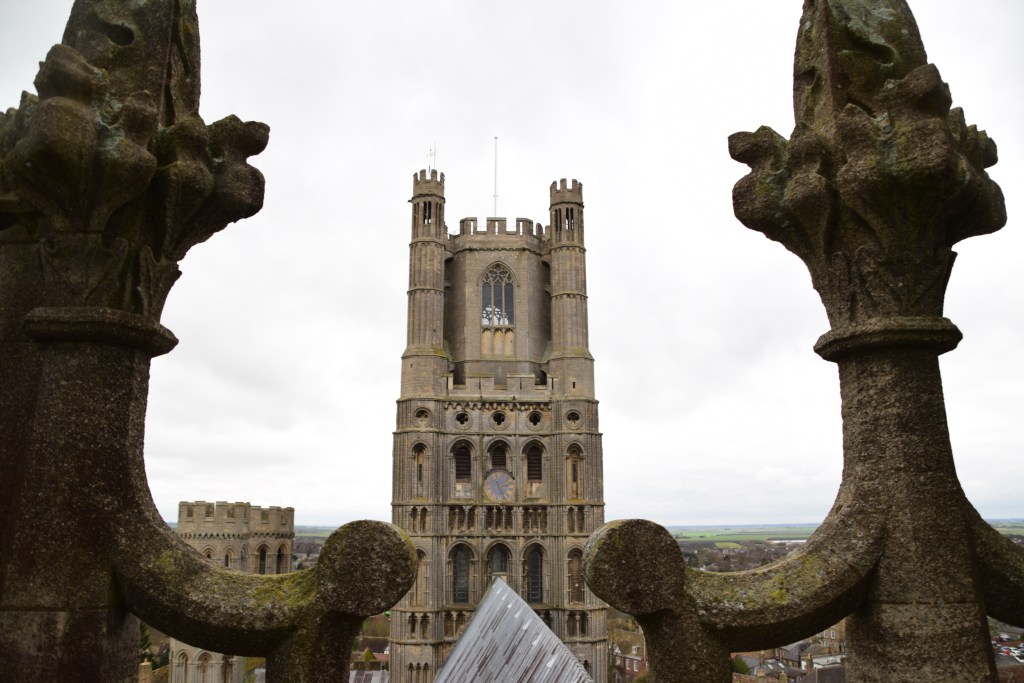

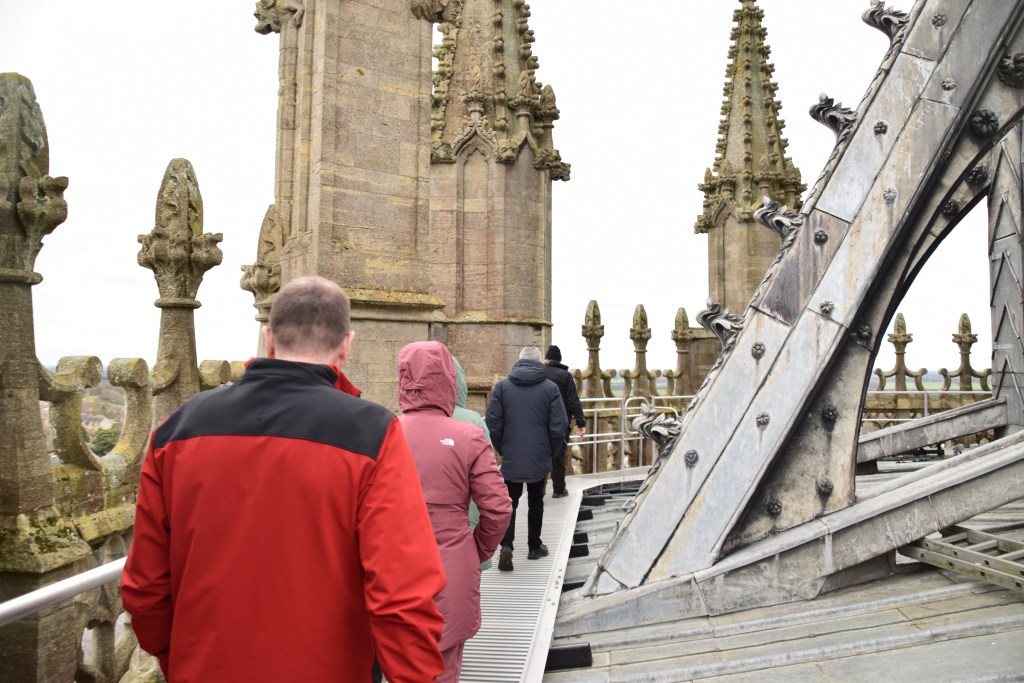
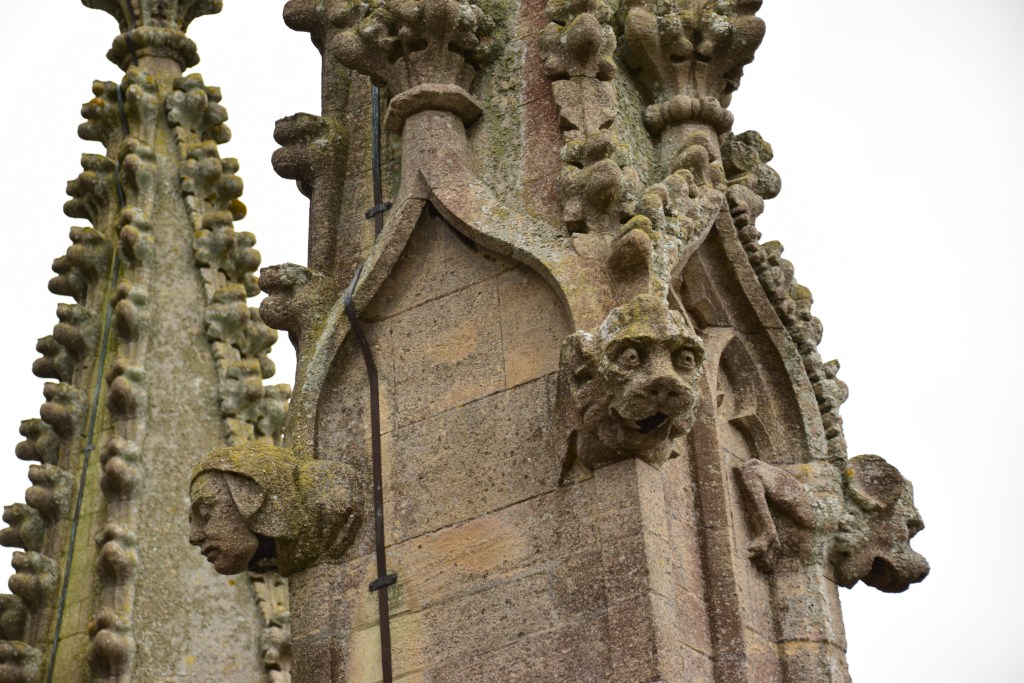

There are lovely green spaces between the Cathedral and the river…
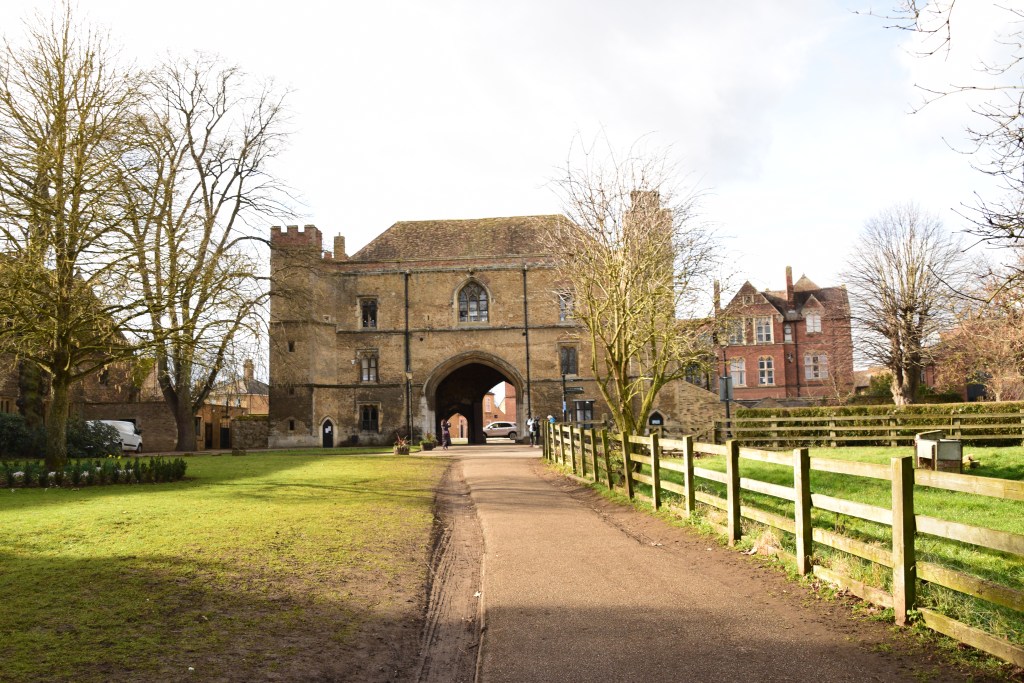




We even finally meet an eel…….
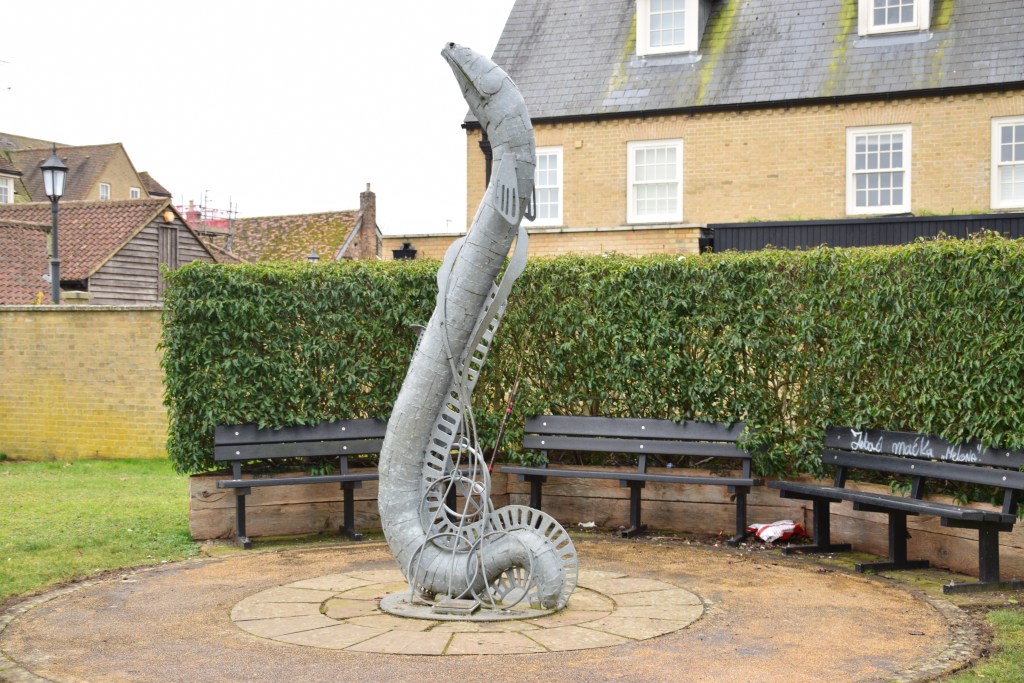
Ely was actually built on an island in the Fens. Being separated from the mainland, the Great Ouse would have been of significant importance for transport until the Fens were drained in the 18th century. A report from 1753 describes a boat leaving Ely every Tuesday and Thursday, laden with passengers and heavy goods, for the 20 mile / six hour journey to Cambridge. Nowadays, it’s main purpose here is that of pleasure, being a popular boating spot with a large marina.

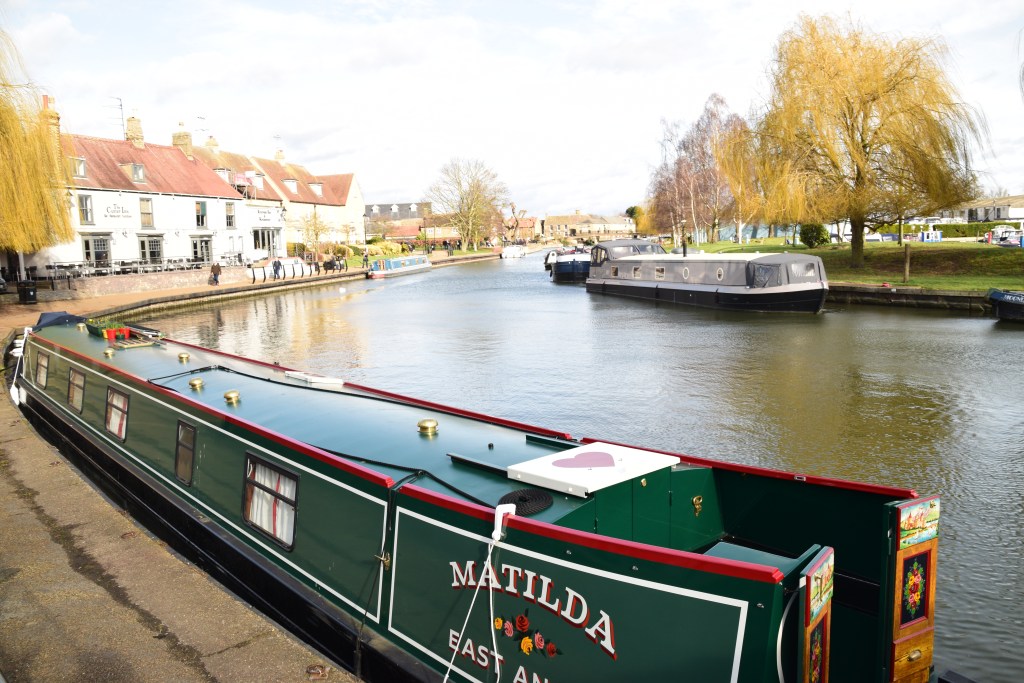



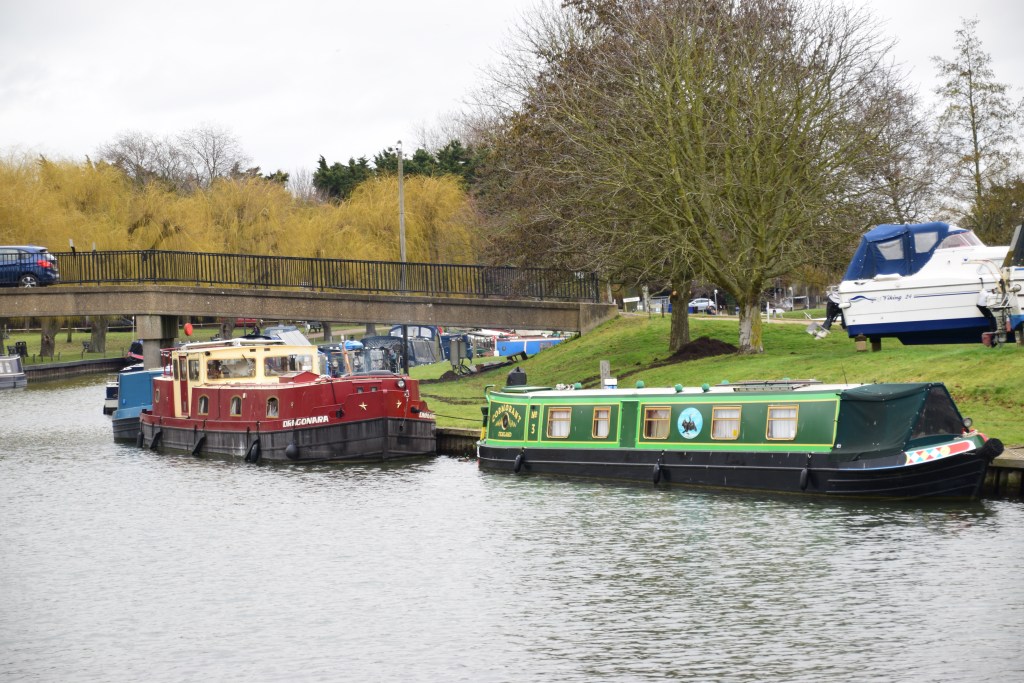
Some listed Maltings buildings along the river have been repurposed – the 1868 Brewery of one Ebenezer William Harlock now serves as a function venue and cinema. A bit further along, another Maltings has enjoyed many revivals – including acting as a morgue during WW2 – and now houses Waterside Antiques which boasts 10,000 sq ft and over 65 dealers.

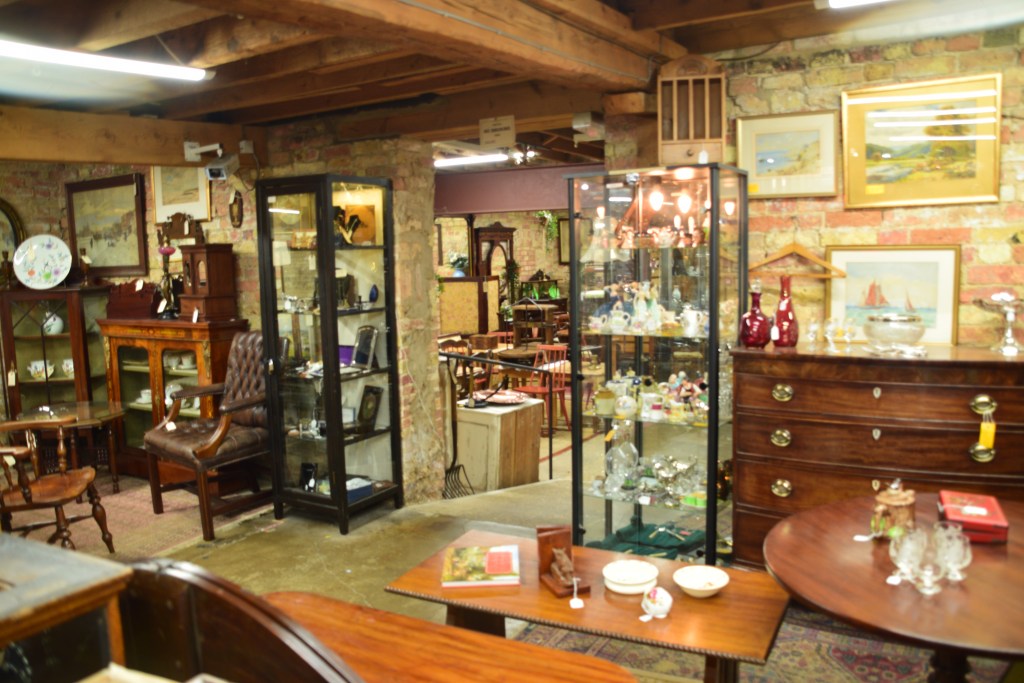
Next to the Waterside, Babylon Gallery promotes local artists as well as regional and national exhibitions..
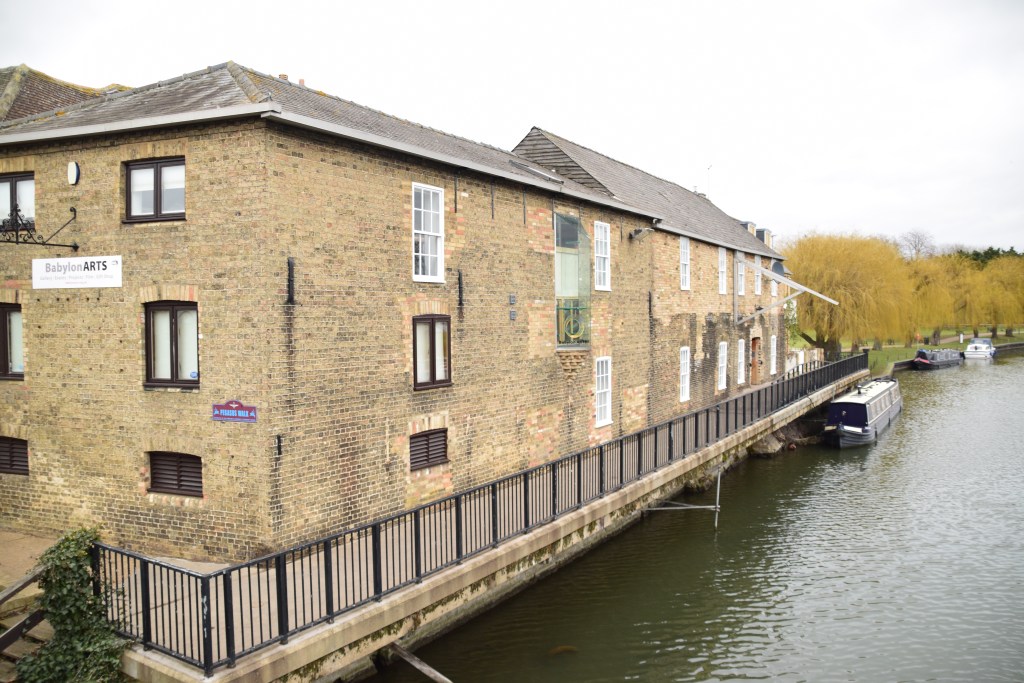
And when you’re finished your browsing through the artworks and antiques, there’s always Peacocks for a Cream Tea!

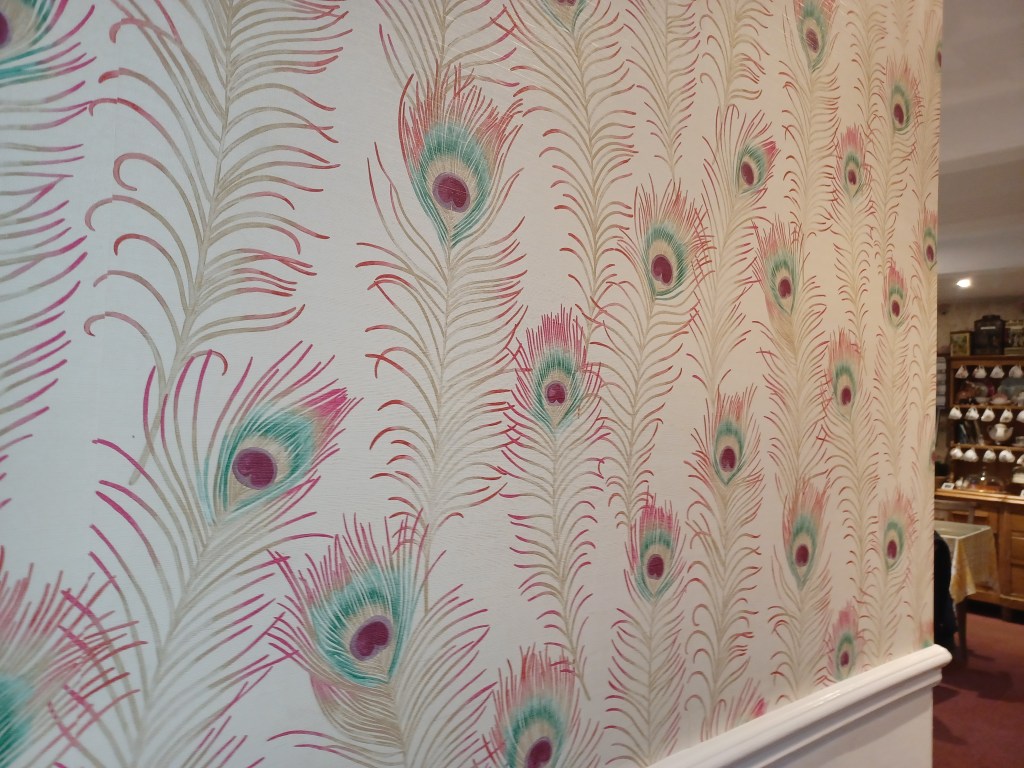
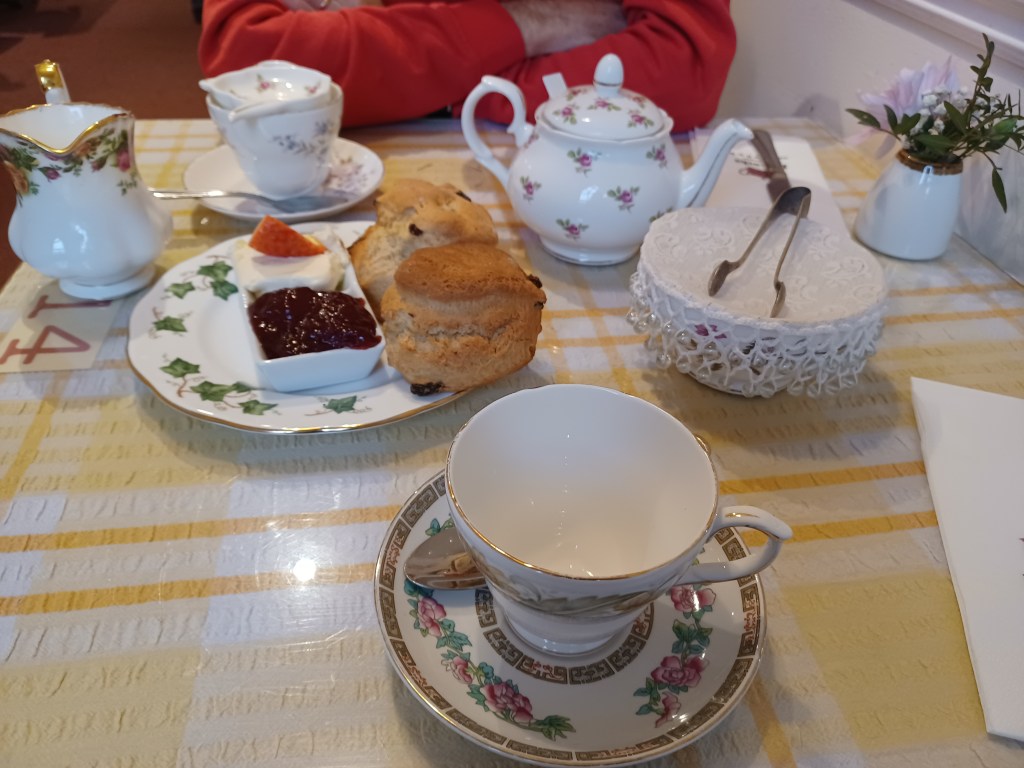
Oliver Cromwell was born into a junior branch of a wealthy Huntingdonshire family so, although he was a gentleman, he was not a rich one. His father died in 1617 and Cromwell left Cambridge to look after the estate, his widowed mother, his wife and their ever growing family. His financial fortune changed when he inherited leases on various properties in Ely from an uncle. He moved his family into one of the properties – a 13th century house – and lived there for 10 years before relocating to London.
This house is one of only two Cromwell homes still in existence (the other being Hampton Court). It is open to the public and visitors can follow an audio tour through the principal rooms. There is a Civil War Exhibition for history buffs while the dramatic among you can dress up in period costumes!
The house doubles as Ely Tourist Information Centre.

On a midweek February day, there was a smattering of day visitors about town – mostly, from what we could gather – from nearby Cambridge. Ely makes for a perfect day trip, taking in the Cathedral, a walk to the river, Oliver Cromwell’s House and a nice lunch. Being off season, it was very quiet at night but I’m sure there’s more of a buzz in summer – indeed, it would make for a great escape from the crowds in Cambridge.
Small Stuff
Getting There:
Train: Stansted Airport > Ely (single) €16.73, incl booking fee
Train: Ely > Cambridge €3.77 / Cambridge > London Liverpool Street €14.72 (Total €18.49 incl booking fees)
Stansted Express: London Liverpool Street > Stansted £16
The Lamb Hotel
Double Room (room only) £99
Cathedral:
Entrance £9
Octagon Tower Tour £10
Note – This year, 2023, the cathedral is celebrating the 1350th anniversary of St. Etheldreda’s founding of her monastery with a year long series of events.
Oliver Cromwell House:
£6.50 (includes audio)



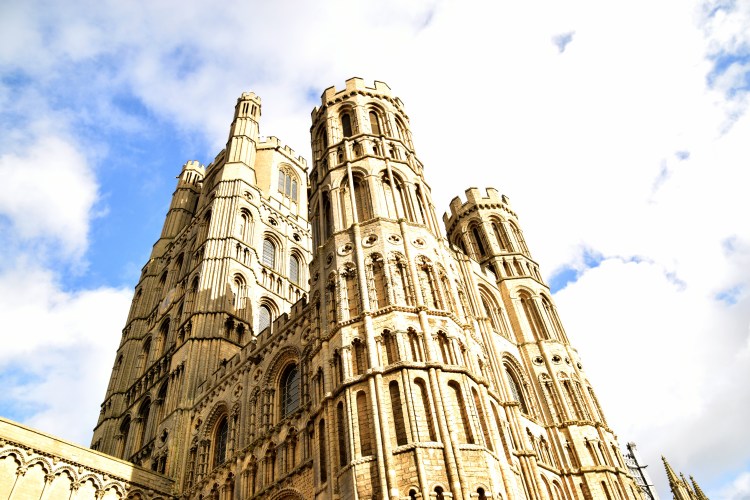
I must visit Ely on my next visit to the UK – and try to remember how to pronounce it. The cathedral looks wonderful.
It’s certainly worth a visit – especially if you are in that part of the country. We joined the 1.30pm Tower Tour and about 6 of the group had travelled from London for the day. They had already walked around the town, were now doing the tour, going to follow with a Cream Tea and then back on the train… Lovely day out..
What an excellent guide, Marie. I visited Ely over 20 years ago as a post grad student studying Medieval History. I was really struck by how the cathedral (once an abbey) is raised up on a hill amongst the flat fenlands. It was easy to image it as an island amonst the reeds. You can also see how revolt against the Norman Conquerors last for some time in this area.
It would certainly be able to hold out for some time, on high ground and surrounded by water and marsh. Wouldn’t have fancied living there back then though!!
It was a real wilderness that the original monks sought out. like the early Desert Fathers.
And sure we see it here also – just look at Glendalough and Skellig Michael. We visited Meteora last summer – extraordinary place…
I havent been to either but I know thwey are both incredible places
They are indeed – it was a privilege to visit both. XXXM
I’ve seen the cathedral from afar but never visited – how remiss of me, it looks lovely! I was interested in your little history lesson too, especially about the deliberation by Henry VIII as to whether cathedrals should be retained (can you imagine the loss if he’d decided against?!)
The bit about Henry and Cathedrals was new to me also – our lesson for today!! A clever and wise move – finding an alternative use rather than totally destruction. I’ll let you off the hook re visiting the place – no one we met in London over the weekend had ever even considered going there!😅 😂
I used to live in Bedford so visited the lovely Ely on a number of occasions. Beyond Ely and towards the Wash, through the low lying fens, is one of England’s most tedious drives…not a hill in sight! As you discovered though, Ely itself is an attractive and interesting little place.
I don’t know the area at all – just Cambridge and now Ely. I’m guilty of assuming that England is all rolling hills!!😅 😂
What a charming place to visit!
Very accessible from London Lissy should you ever make it there…..
Great vivid post, love that cathedral whatever her name is lol !!
Bit of a mouthful isn’t it!!!😅 😂
Yes lol !
A couple of decades ago, we spent an afternoon in Ely. The cathedral is absolutely amazing. We climbed the tower, and up on top is a bust of my cousin. He was the principle stone Mason there for decades and the Bishop (?) said he could do a bust of himself (apparently that was very common in the old days) and he chose the tower. Quite the amazing view. Thanks for the reminder of my memories.
Bernie – you told me that last year when I wrote about Cambridge!!!! Oh I wish I’d remembered – the tour group would have been SO impressed with that info!!
Silly me for telling you the same story twice! I was just so excited to see the top of the tower! Bernie
Not at all Bernie!! I’m just raging that I’d forgotten!!
Wow, how did this one stay under the radar. The town is very cute and the cathedral is magnificent. But they should have spelled it Eeley maybe. Maggie
It is lovely Maggie but then I suppose there are so many gorgeous towns in England that it would take a few visits at least before reaching Ely on the list! As for the spelling – it probably started out with Eeley or similar…maybe some local bigwig decided to raise the tone and posh it up a bit!!
Thanks for the tour! They don’t make names like they used to: Etheldreda. Beautiful photos.
Kids would get a tough time nowadays with that mouthful!!😅 😂
I loved my visit to Ely. Caught the local bus out and the train back. I hope to go back some time when I can get myself from Australia to England, and stay the night to catch up on what I missed out on. Your post brought back lots of memories, especially of the AMAZING cathedral.
Glad you enjoyed, Coral. I love reading posts that evoke memories from my own travels. Hope you make it back one day. XXXM
Great read Marie as usual. The reference to Henry VIII and the dissolution of the monasteries resonated with me, as the same thing happened in Ireland. Just wondering also if there was any mention of ” to hell or to Connaught” when visiting Cromwell’s domain. I expect not but both of these ” gentlemen ” left a long lasting legacy and not one that we’re particularly fond of.
We didn’t come across anything Barry. That was from a later period – he was probably still a nice guy when living in Ely😅 😂
You were just down the road – I live 10 mins from Ely and my husband grew up there!
That’s right – I remember you mentioning it last year when we were in Cambridge… Sounds ideal – you live in a lovely place but still close enough to all the perks of London….
Impressive stuff. I will need to visit again.
Thank you Henry – glad you enjoyed.
Wonderful overview of Ely and gorgeous photos!
Thank you – we’d a lovely time. XXXXMarie
I live in Ely. Your blog is a great account with wonderful pictures.
Thanks Angela – must be a nice place to live – and still close enough to all the facilities that London has to offer. It was a very easy trip for us from Stansted. Is it busy in summertime?
Nice to ‘meet you’ btw! XXXMarie
Yes, quite busy but it’s a little market town so never crowded. Glad u enjoyed our little city. You certainly packed in lots.
Being retired, I don’t have to go away for a rest or a destress – so I keep going and see as much as I can – of course, I fall apart once I get home!!!😅 😂
I visited it briefly a long time ago. such a charming little town
Definitely worth a visit I think….
I visited there from nearby Downtown Market where I was staying with friends. I enjoyed my day there but would have benefitted from a little more time alone maybe, to have explored more. The cathedral is very impressive I must say, and I managed to find the ‘green man’ which I always look for in England’s cathedrals. Great photographs as well, and thanks for the trip down memory lane.
Glad you enjoyed, Mari🥰 😘